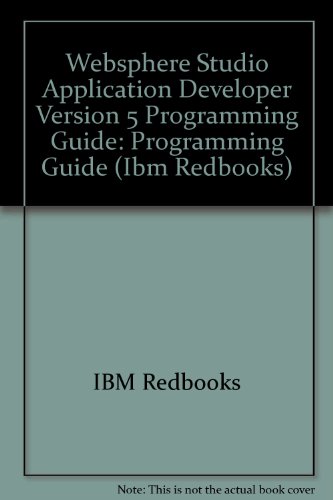

Most ebook files are in PDF format, so you can easily read them using various software such as Foxit Reader or directly on the Google Chrome browser.
Some ebook files are released by publishers in other formats such as .awz, .mobi, .epub, .fb2, etc. You may need to install specific software to read these formats on mobile/PC, such as Calibre.
Please read the tutorial at this link. https://ebooknice.com/page/post?id=faq
We offer FREE conversion to the popular formats you request; however, this may take some time. Therefore, right after payment, please email us, and we will try to provide the service as quickly as possible.
For some exceptional file formats or broken links (if any), please refrain from opening any disputes. Instead, email us first, and we will try to assist within a maximum of 6 hours.
EbookNice Team

Status:
Available5.0
18 reviews
ISBN 10: 0738499579
ISBN 13: 9780738499574
Author: IBM Redbooks, Ueli Wahli, International Business Machines Corporation
This IBM Redbooks publication is part of a series of four volumes that are related to WebSphere Everyplace Access Version 5.0. You can use this series to plan, install, administer, and develop mobile applications to run in a WebSphere Everyplace Access Version 5.0 environment. The information that this series provides targets business-to-employee enterprise applications. However, most of the scenarios presented apply to business-to-consumer applications as well.
This book provides step-by-step sample scenarios that describe how to implement Intelligent Notification Services to notify Lotus Sametime, SMTP e-mail, and other channel deliveries. It also includes scenarios that illustrate the Location Aware Services function which provides access to location-based services from multiple vendors using available APIs. It also includes a chapter that discusses how to cluster WebSphere Everyplace Access nodes as well as how to integrate your server with IBM WebSphere Connection Manager to implement single sign-on.
This book is targeted to application developers, IT architects, IT specialists, and administrators who want to install, administer, and develop enterprise applications to run on IBM WebSphere Everyplace Access.
Please note that the additional material referenced in the text is not available from IBM.
Chapter 1: Intelligent Notification Services
Introduction to Intelligent Notification Services
Intelligent Notification Services Architecture
Subscription Manager
Content Adapter
Preferences Manager
Member Services
Notification Manager
Trigger Handler
Channel Adapters
Configuration
Channel Adapter
Mail and Calendar Service
Managing Users
Starting and Stopping the Server
Message Logging
User Portlets Configuration
My Delivery Channels (1/2)
My Delivery Channels (2/2)
My User Groups Portlet
My Message Rules
My Subscriptions (1/2)
My Subscriptions (2/2)
Administration Portlets Configuration
Removing User Preferences
Configuring Admin Email Info
Sending Actions
Scenarios
Stock Example (1/2)
Stock Example (2/2)
Mail and Calendar Services (1/2)
Mail and Calendar Services (2/2)
Chapter 2: Simple Notifications
Overview
Delivery Preferences
Sample Scenario
Description
Sample Application Development (1/2)
Sample Application Development (2/2)
Running the Scenario (1/2)
Running the Scenario (2/2)
Chapter 3: Subscription-Based Notifications
Overview
Sample Scenario
Content Adapter
Developing a Content Source Program
Deploying a Content Source Program
Developing a Content Adapter Application (1/2)
Developing a Content Adapter Application (2/2)
Deploying a Content Adapter
Trigger Handler
Developing and Deploying
Subscription Portlet
Developing and Deploying
Running the Sample Scenario
Chapter 4: Server-Initiated Actions
Overview
Description
Sample Scenario
Requirements
Chapter 5: Location Aware Services
Introduction
Architecture
Service Adapters
Portlet Service
Installing and Configuring
Installation Overview
Admin Portlets
Server Settings
Mapping and Directions Sample Portlet
Getting a Map
Adding Locations
Getting Directions
Points of Interest
LAS on Devices
Troubleshooting
Chapter 6: Location Aware Services Application Development
Developing a LAS Portlet
Creating a LAS Project
Testing the Portlet (1/3), (2/3), (3/3)
Enhancements
Deploying the Portlet
With LAS Installed
Without LAS Installed
Java App Development
Summary
Developing an Adapter
Registering the Adapter
LAS API
Other Sources
WebSphere Studio InfoCenter
Portal and Everyplace Toolkit
Chapter 7: Clustering WebSphere Everyplace Access Nodes
Overview of Clustering
Using Network Deployment
Terminology
Clustering Topologies
Clone Topology
Distributed App Server and Portal
Component Setup
Windows OS Prereqs
DB Node, LDAP Node
WAS Nodes (1/2), (2/2)
Portal Node
Configuring Portal with DB2
WAS ND Node
Installing & Clustering
Adding Portal and WAS Nodes
Installing WPA Services (1/2), (2/2)
Setting Up Synchronization Server (1/2), (2/2)
Regenerating Plug-in Config
Recycling Deployment Manager
Creating Cluster and First Member
Chapter 8: Using Everyplace Connection Manager HTTP Access Services
Overview
Multiple Servers (Single/Multiple Hostnames)
Sample Scenario
Creating a Server Certificate
HTTP Access Services Configuration
Running the Scenario
Desktop Clients
PDA Clients
Troubleshooting
Connection Manager on SUSE Linux (1/2), (2/2)
Chapter 9: WebSphere Connection Manager Integration
WPA Integration
Common Configurations
LDAP Considerations
Sample Scenario Setup (1/3), (2/3), (3/3)
Running the Scenario
PDA Clients
Chapter 10: WebSphere Connection Manager Single Sign-On Using LTPA
Overview of SSO with LTPA
Sample Scenario (1/2), (2/2)
ECM Configuration
Authentication Profile
Enabling HTTP Access Services
Directory Services Server
Access Manager
WPA Configuration
Running the Scenario
PDA Clients
Troubleshooting
websphere studio application developer
websphere development studio
websphere application developer
ibm websphere studio
websphere developer edition
websphere application server developer edition
Tags: IBM Redbooks, Ueli Wahli, International Business Machines Corporation, Websphere, Application